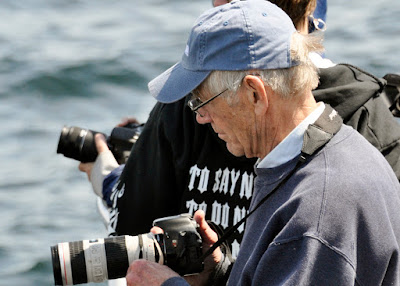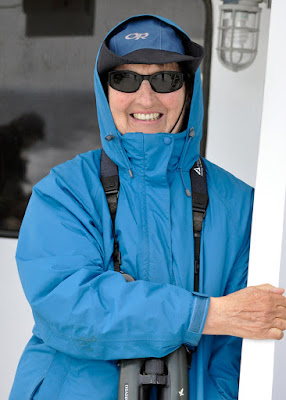Ocean Exploration Cruise - June 11, 2017 from 8 am to 4 pm
Cetacean Sightings:
1 basking shark
4 - 5 Harbor porpoise
1 Humpback whale - Nile
3 - 4 Minke whales
1 Finback whale
Seabird Sightings:
30 Common Eider (harbor)
1 White-winged Scoter
3 Manx Shearwater
15 Northern Gannet
13 Double-crested cormorant (harbor)
1 Glossy Ibis (harbor)
3 Black-bellied Plover
60 Herring Gull
20 Great Black-backed Gull
32 Rock Pigeon (harbor)
6 Chimney Swift (one at sea)
1 American crow
5 Barn swallow (harbor)
1 Common grackle (harbor)
2 American Goldfinch (harbor)
1 House sparrow
To read Thomas Robben's Trip Report, go to his website "Seabirds, Marine Surveys and Changing Ocean EcoSystems" by clicking
HERE:
We left out of Gloucester, MA at 8 am with fair winds and clear skies. Our first destination was the northwest corner of Stellwagen Bank. Yesterday, 7 Seas Whale Watch had picked up a small number of whales and seabirds in that area and we were hoping that these animals had stayed in the vicinity.
 |
| Basking shark just under the surface. |
When we approached the northwest corner, we picked up a basking shark that was filter feeding at the surface. Basking sharks are the second largest shark in the world and the largest shark that feeds in our cold New England waters each spring, summer, and fall. This animal had a very large dorsal fin which we can use to identify it in the future. As the boat slowly approached, the shark moved down port side of the boat and disappeared beneath the surface. We waited a few minutes for the animal to come back up, but realized that this shark was not about to return for a repeat performance.
 |
| Large, floppy dorsal fin of this basking shark. |
The New England Coastal Wildlife Alliance has a community-sighting network for basking sharks and ocean sunfish seen in our New England waters. If you see either of these large, pelagic species, please go to www.nebshark.org and report your sighting.
Report both live and dead animals to the sighting network. If the animal is live and doing well, go to our website at www.nebshark.org to report your sighting. If the animal is dead, we prefer that you call us at 508-566-0009 to alert us to the presence of the carcass on the beach.
 |
| Basking shark with dorsal fin just breaking the surface. |
For live sighting: report the date, time, position (latitude and longitude) of the animal or animals. Indicate the number of animals in the sighting and document the behaviors. Take lots of photos and upload as many as you can on our website. You can email additional photos and video to NECWA via our work email which is contact@necwa.org.
For dead basking sharks or ocean sunfish: report the date, time, position (latitude and longitude) of the carcass and take lots of photos. Call our stranding and rescue number (508-566-0009) to alert us to the carcass as soon as you can. Often the tide will move a carcass and sometimes it will take the carcass back out to sea.
 |
| Juvenile Northern gannet. |
When we arrived on the northwest corner, we were not able to relocate the whales and seabirds that had been the day earlier, so decided to head south and work our way along the edges of Stellwagen Bank. As we headed south, we picked up a small group of harbor porpoise that were charging in the glare right off the bow. Harbor porpoise are the smallest of the toothed whales in our area and they are quite shy and therefore, often hard to get a good look at. About this time, we also started sighting seabirds, including Northern gannets, both adult and juveniles, but none appeared to be feeding at the surface.
 |
| Juvenile Northern gannet. |
As we kept heading south, NECWA staff member, Tammy Silva, spotted a blow at the southeast end of Stellwagen Bank. We thought we had a humpback or finback whale, but as we waited for the animal to return to the surface, we realized that we had been fooled by a minke whale.
 |
| Minke whale. |
Minke whales are the smallest of the baleen whales that feed off Cape Cod this time of the year. Typically they don't create a blow or spout and are therefore, difficult to spot at the surface. As we head position, we reapplied that we had 2 or 3 minkes whales that were surfacing at different times around the boat.
 |
| Nile and the white mark on her right dorsal fin. |
 |
| Left dorsal fin of Nile. |
As we continued east, we picked up a larger blow and this time we realized that we had a humpback whale. As we watched this whale approach the boat, NECWA staff member Leah Horeanopolous shouted out in delight that this was Nile, her favorite whale. Nile has a hooked dorsal fin with a white mark on the right side. This makes identifying her quite easy, even from a distance.
Even though Nile's dorsal fin is so unique, it is the ventral or bottom surface of her flukes (tail) that provided the field mark for her name. On the left ventral surface of her flukes, you see a thick black line that splits as it descends down. This mark looks like the Nile River and this is how Nile got her name.
 |
| Field mark on left ventral tail surface that provided Nile her name. |
As we were watching Nile, a large finback whale surfaced right off our port bow and crossed over to the starboard side of the boat. Finback whales are the second largest of all the baleen whales and the largest that is often seen feeding in New England waters.
 |
| Finback whale! |
Before we knew it, we had to turn around and head back to Gloucester. We were able to download the GPS trackless and add on the various cetacean or whale sightings we had over the course of the trip. Looking at the track log, we realized just how much water we had actually covered. That is the benefit of an all day trip for it provides us the time to travel far once we get offshore.
 |
| Track log for Ocean Exploration Cruise with cetacean sightings. |
We were able to collect plankton after we conducted a plankton tow on the southern end of Stellwagen Bank. NECWA staff members Leah, Starr Howell, and Tom Robben, along with NECWA interns Joe Bertherman and Neil Henry had fun conducting the tow.
 |
| Leah throwing the net over the side of the boat. |
 |
| The net just under the water. Perfect! |
 |
| Leah and Joe! |
 |
| Pulling the net back into the boat |
 |
| Leah and Starr having fun during the plankton tow! |
NECWA interns were also involved with conducting a marine debris survey on the way offshore and on the way back to port. NECWA interns Brianna-Rose Lamb, Joe Bertherman, and Neil Henry did a great job of recording and photographing all the marine debris that was seen from the vessel.
 |
| Brianna recording data. |
 |
Neil Henry scanning for marine debris.
 |
My favorite part of any all day trip is being able to spend time with some fabulous folk. Here are some photos I was able to take over the course of the trip. Enjoy!



















































































Comments
Post a Comment